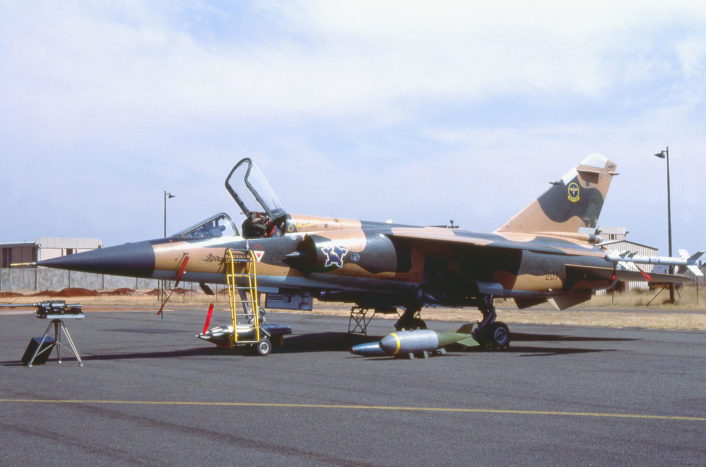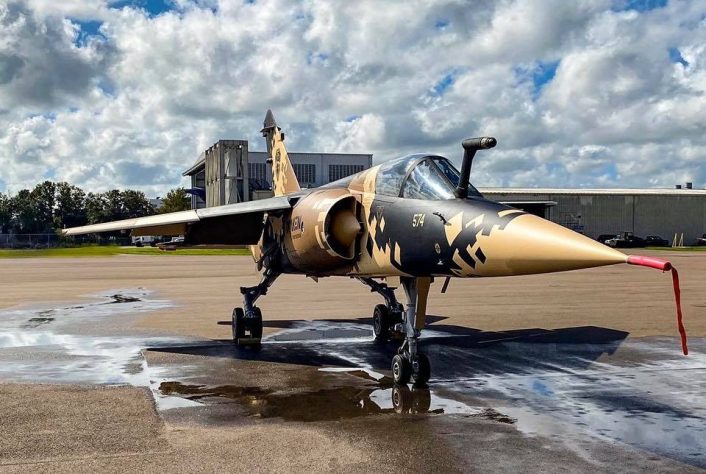A former Spanish Air Force Mirage F1M, now registered N574EM, is about to move to Nellis Air Force Base to start providing advanced adversary services to the U.S. Air Force. In a pretty cool digital paint scheme.
The role of Aggressors is to train fighter pilots in the most realistic way: the must fight aircraft that are as analogous as possible to the real threat.
In the U.S., both the U.S. Air Force and the U.S. Navy have their own aggressors/adversary units that replicate paint schemes, markings, insignas and, above all, the tactics, used in combat by their near peer adversaries: the USAF has the F-16s of the 64th and 18th AGRS (Aggressor Squadron), respectively at Nellis Air Force Base, Nevada, and Eielson AFB, Alaska; the U.S. Navy’s adversary component is provided by the VFC-13 Fighting Saints and their F-5N Tigers II (ex-Swiss Tigers) in “Rotten Banana” and “Mig-28” schemes, and by the dedicated reserve adversary squadrons such the VFC-12 and VFA-204 with their F/A-18C Legacy Hornets (A, B, A+, C variants) respectively based at NAS Oceana and NAS New Orleans; VMFT-401 is the United States Marine Corps’ only adversary squadron flying the F-5N at Marine Corps Air Station Yuma, Arizona.
As Lieutenant Commander Graham Scarbro, U.S. Navy, explained in “Fix Naval Aviation’s Adversary Problem“, Proceedings, Nov. 2008:
“Many of these aircraft lack higher-end radars, data link, helmet mounted sights (HMS), glass cockpits, heads-up display (HUD), and high-off boresight missiles. They also lack many civil aviation fundamentals such as GPS, required navigation performance area navigation (RNP-RNAV), and instrument landing systems. These upgrades are slow in arriving because money is needed to rebuild the front-line fleet.”
Other countries do have their own adversary squadrons or rely in “low cost” alternatives.
In Italy, for instance, since the second half of 2015, the Eurofighter Typhoon squadrons of the Italian Air Force (Aeronautica Militare, AM) have started cooperating with the 212° Gruppo (Squadron) that is responsible for the LIFT (Lead-In Fighter Training) course and has employed their new T-346A Master advanced jet trainers in the Aggressors role. The aim of this cooperation is to optimize the available resources: with the T-346 replacing the Typhoon in the adversary role, the service has offloaded a significant number of sorties from the Eurofighter line to a cheaper yet quite performing aircraft, without affecting the quality of the training. While the T-346s have provided adversary “services” during NATO TLP (Tactical Leadership Training) courses, the aggressor mission is secondary to their advanced jet training role.
Generally speaking, the problem is that aggressor squadrons are costly to operate and maintain: air arms need experienced aircrews, constant training and the proper asset. For this reason, both in the U.S. and abroad, even those air forces who have the assets, budget and experience to insource adversary support services increasingly rely on contracted aggressor services provided by private companies.
They call it CAS: contract air services. Companies like ATAC, Draken International and TacAir have been working with the U.S. military since more than a decade, committing their jets to replicate high-end real-world threats. And this is going to continue in the future: the U.S. Air Force has awarded a multi-billion dollar contract to seven different companies (the above mentioned ones along with Air USA Inc., Blue Air Training, Coastal Defense and Top Aces Corporation) last month.
Considered the expanding market, these company continue to buy aircraft to enhance the services they can provide to the U.S. Air Force and other DoD customers. For instance, TacAir acquired some ex-Royal Jordanian Air Force F-5E Tiger II jets, upgrading them into what they now call the F-5AT Advanced Tiger configuration, while both ATAC and Draken have purchased second-hand, upgraded Dassault Mirage F1 (from France and Spain).
In 2017, Draken International announced the procurement of 22 Mirage F1M and F1B fighter jets. Previously flown by the Spanish Air Force, these aircraft will join Draken’s existing fleet of radar-equipped Douglas A-4K Skyhawks and Aero Vodochody L-159E “Honey Badger” fighter jets to support Draken’s Nellis AFB ADAIR contract which provides adversary training for the USAF Weapons School, Red Flag exercises, operational test support, RTU support, and Combat Air Forces abroad.
“In 1996, the Spanish Air Force, along with Thomson-CSF (Thales Group), spent $96M on a modernization upgrade, including cockpit enhancements, LCD MFDs, Advanced HUD, INS/GPS, Electronic Attack systems and a special performance upgrade for the Cyrano IVM radar. The Spanish Mirage F1M fleet was decommissioned in February 2013 and stored in Albacete Air Base, Spain until Draken’s purchase in September 2017. After extensive research, these Mirage F1s proved to be the best equipped and lowest time fighters of their kind available to the industry,” said a company news release last year.
Last week, Draken unveiled the first of its Mirage F1 at the company’s Lakeland, Florida facility.
Here are the first photographs:
The aircraft sports a digitized desert camouflage that is inspired by the modern digital patterns also sported by the Russian aircraft but also reminds of the color scheme of the South African Air Force Mirage F1CZ.

The upgraded Mirage F1s are high-end adversaries that can be extremely useful for training both 4th and 5th generation fighter pilots. These fast combat-proven jets bring supersonic speed and good radar to the fight, representing a further enhancement to the capabilities offered in the air-to-air scenario (and not only in that one).

Here’s what I wrote in a previous post here at The Aviationist commenting the footage of an F-22 engaging a Draken A-4 over Nevada. It explains why modern combat aircraft train against previous generation aircraft and why this kind of training is relevant:
Someone may argue the A-4 Skyhawks are quite obsolete aircraft and not even comparable with modern 4th generation enemies. True, but these are the same aggressors that train many modern combat planes (don’t forget the F-22s practice their air-to-air skills against the T-38s) and take part in Red Flag exercises.
The footage shows a U.S. Air Force F-22 Raptor engaging with an A-4K Skyhawk in the Nellis Test and Training Range. The Skyhawk is one of the jets belonging to Draken International, a company that supports military training around the globe with a fleet of 80 tactical fighter aircraft. The extensively upgraded in the early 1990s to a standard similar to the F-16 Mid-Life-Update with a 1553 digital bus, APG-66v7 radar, RWR (Radar Warning Receiver), HOTAS (Hands On Throttle And Stick) controls, HUD (Head Up Display) and MFDs (Multi-Function Displays). In other words, although not the most advanced Aggressors around, at least what’s needed to perform the adversary role against 4th and 5th generation combat planes.
As explained by an F-35 pilot last year, dogfighting against the A-4 is still relevant today for several reasons:
- The F-35’s sensors and “fusion” provides me as a pilot with good situational awareness. For an F-35 to simulate an opponent against another F-35, it has to restrict the effects of fusion and the various sensors. Even then it is difficult to “dumb down” the aircraft enough. It requires discipline to not be tempted to using information that an opponent in reality would not have access to.
- The A-4s we faced in these exercises had sensor performance along the lines of our own upgraded F-16s. They also carried jammers intended to disturb our radar.
- The pilots we faced were very experienced. We are talking 2000 hours plus in aircraft like the F-16, F-15E, F-15C and the F-22, with detailed knowledge of “fifth generation” tactics and weapons. When also cooperating closely with intercept controllers on the ground (GCI) they could adapt the training and offer us a reactive and challenging opponent. Note the word “reactive.”
- The A-4 is a small aircraft with a corresponding signature. Many potential opponents in the air are bigger and easier to find than the tiny A-4.
By the way, CAS will not completely replace insourced aggressor services, as proved by the news, dated May 2019, that the U.S. Air Force will reactivate the 65th Aggressor Squadron (65th AGRS) and move 11 F-35A Lightning IIs to Nellis Air Force Base, Nevada, “as part of a larger initiative to improve training for fifth generation fighter aircraft.” Indeed, the emergence of a “stealth threat” among the “enemy lines” (i.e. China and Russia) and the fact that for the next 10-15 years the majority of the U.S. aircraft will be “legacy” ones (NATO says 70 percent of its fleet), force the U.S. Air Force to invest in training of 4th and the 5th generation pilots to to face other stealth aircraft in combat. And, considered that no civilian contractor can field stealth jets, early production F-35s, are perfect for the role.








